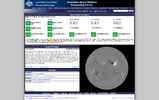Derecho With 100-mph Winds Rips Across Midwest As well As Canadian Wildfire Smoke - Crestone 4th!
Friday, Jun. 30, 2023
MINOR GEOMAGNETIC STORM WATCH: NOAA forecasters say that a CME might graze Earth's magnetic field on July 1st.

Friday, Jun. 30, 2023
MINOR GEOMAGNETIC STORM WATCH: NOAA forecasters say that a CME might graze Earth's magnetic field on July 1st.
It was launched into space three days ago by an erupting magnetic filament in the sun's northern hemisphere. The glancing blow, if it occurs, could spark a minor G1-class geomagnetic storm. Aurora alerts: SMS Text
GIANT SUNSPOT ALERT: When this week began, sunspot AR3354 didn't exist. Now it is 10 times wider than Earth and still growing. The sunspot burst into view on June 27th, breaching the surface of the sun, then blossoming into a giant over the next 48 hours: movie.
AR3354 is so big, amateur astronomers can see details normally reserved for the world's greatest telescopes. Michael Karrer sends this picture of the sunspot's dark heart from his backyard observatory in Austria.
"Despite its gigantic size, the sunspot was not as easy to photograph as I expected," says Karrer. "The jetstream brought variable seeing to my observatory. But in a few moments of fair conditions I was able to capture this high-resolution image."
Karrer's photo shows that the sunspot's heart is not completely dark. It is peppered by "umbral dots"--incandescent balls of plasma rising and falling in the sunspot's core. Researchers believe they are turbulent convection cells, which dredge up heat from ~1000 km below. The same kind of motions can be seen in a pan of water boiling on a hot stove. The photo also resolves hundreds of "penumbral filaments," fine magnetic tubes that transport energy out of the sunspot.
While many astronomers are using telescopes to examine the sunspot, telescopes are not required. AR3354 can be seen without any magnification. If you have eclipse glasses, put them on and take a look. Solar flare alerts: SMS Text
more images: from Stuart Green of Preston, Lancashire, UK; from Francisco A. Rodriguez of Vega de San Mateo, Gran Canaria, Canary Islands; from Mahdi Rahimi of Esfan, Iran; from Michael Karrer of Austria






